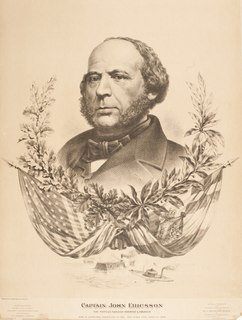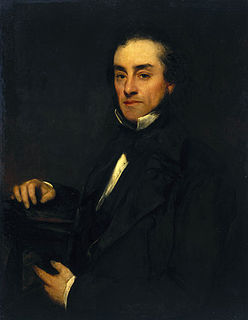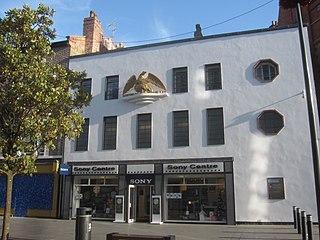Related Research Articles

A propeller is a device with a rotating hub and radiating blades that are set at a pitch to form a helical spiral which, when rotated, exerts linear thrust upon a working fluid such as water or air. Propellers are used to pump fluid through a pipe or duct, or to create thrust to propel a boat through water or an aircraft through air. The blades are specially shaped so that their rotational motion through the fluid causes a pressure difference between the two surfaces of the blade by Bernoulli's principle which exerts force on the fluid. Most marine propellers are screw propellers with helical blades rotating on a propeller shaft with an approximately horizontal axis.

John Ericsson was a Swedish-American inventor. He was active in England and the United States.

A steamship, often referred to as a steamer, is a type of steam-powered vessel, typically ocean-faring and seaworthy, that is propelled by one or more steam engines that typically move (turn) propellers or paddlewheels. The first steamships came into practical usage during the early 1800s; however, there were exceptions that came before. Steamships usually use the prefix designations of "PS" for paddle steamer or "SS" for screw steamer. As paddle steamers became less common, "SS" is assumed by many to stand for "steamship". Ships powered by internal combustion engines use a prefix such as "MV" for motor vessel, so it is not correct to use "SS" for most modern vessels.

A steamboat is a boat that is propelled primarily by steam power, typically driving propellers or paddlewheels. Steamboats sometimes use the prefix designation SS, S.S. or S/S or PS ; however, these designations are most often used for steamships.

Richard Jordan Gatling was an American inventor best known for his invention of the Gatling gun, which is considered to be the first successful machine gun.

James Henry Greathead was a mechanical and civil engineer renowned for his work on the London Underground railways, Winchester Cathedral, and Liverpool overhead railway, as well as being one of the earliest proponents of the English Channel, Irish Sea and Bristol Channel tunnels. His invention is also the reason that the London Underground is colloquially named the "Tube".

Robert Field Stockton was a United States Navy commodore, notable in the capture of California during the Mexican–American War. He was a naval innovator and an early advocate for a propeller-driven, steam-powered navy. Stockton was from a notable political family and also served as a U.S. senator from New Jersey.

John Fitch was an American inventor, clockmaker, entrepreneur and engineer. He was most famous for operating the first steamboat service in the United States. The first boat, 45 feet long, was tested on the Delaware River by Fitch and his design assistant Steven Pagano.

Aaron Ogden was an American soldier, lawyer, United States Senator and the fifth governor of New Jersey. Ogden is perhaps best known today as the complainant in Gibbons v. Ogden which destroyed the monopoly power of steamboats on the Hudson River in 1824.

Sir Francis Pettit Smith was an English inventor and, along with John Ericsson, one of the inventors of the screw propeller. He was also the driving force behind the construction of the world's first screw-propelled steamship, SS Archimedes.

John Braithwaite, the younger, was an English engineer who invented the first steam fire engine. He also co-designed the first locomotive claimed to have covered a mile in less than a minute.

Matthias Ogden was an American soldier and politician. He fought in the American Revolutionary War, and served in various political positions afterwards.

The United States Consulate in Liverpool, England, was established in 1790, and was the first overseas consulate founded by the then fledgling United States of America. Liverpool was at the time an important center for transatlantic commerce and a vital trading partner for the former Thirteen Colonies. Among those who served the United States as consul in Liverpool were the writer Nathaniel Hawthorne, the spy Thomas Haines Dudley, and John S. Service, who was driven out of the United States Foreign Service by McCarthyite persecution. After World War II, as Liverpool declined in importance as an international port, the consulate was eventually closed down.

SS Archimedes was a steamship built in Britain in 1839. She was the world's first steamship to be driven successfully by a screw propeller.

Coleman Sellers II was a prominent American engineer, chief engineer of William Sellers & Co., professor of mechanics at the Franklin Institute, professor of engineering practice at Stevens Institute of Technology and inventor. He obtained more than thirty letters-patent for inventions of his own, and served as president of the American Society of Mechanical Engineers from 1886 to 1887.

A screw steamer or screw steamship is an old term for a steamship or steamboat powered by a steam engine, using one or more propellers to propel it through the water. Such a ship was also known as an "iron screw steam ship".

John Patch was a Nova Scotian fisherman who invented one of the first versions of the screw propeller.
Robert Wilson FRSE FRSSA was a Scottish engineer, remembered as inventor of a special kind of a screw propeller, which he demonstrated in 1827. Wilson also designed a self-acting motion for steam hammers which was key to making them practical for industrial use, among many other inventions.

A team boat, horse boat, or horse ferry, is a watercraft powered by horses or mules, generally using a treadmill, which serves as a horse engine. Team boats were popular as ferries in the United States from the mid-1810s to the 1850s.
Isaac Dripps was an American machinist and inventor. He worked on the locomotive John Bull and built seven locomotives. Dripps was a superintendent and partner of various railroad machinery shops. He has several patents to his name.
References
- ↑ Congressional Edition. Vol. 191. U.S. Government Printing Office. 1829. p. 408.
- ↑ Niles, Hezekiah; Niles, William Ogden; Hughes, Jeremiah; Beatty, George (Jan 9, 1841). Niles' Weekly Register. Vol. 59–60. p. 290.
- 1 2 3 4 Thulesius, Olav (2007). The Man who Made the Monitor: A Biography of John Ericsson, Naval Engineer. McFarland. pp. 43–46. ISBN 9780786427666.
- 1 2 Brockman, R. John (2009). Commodore Robert F. Stockton, 1795-1866: Protean Man for a Protean Nation. Cambria Press. pp. 96–99. ISBN 9781621969617.
- ↑ The Coat of Arms magazine, N.S.Volume X. No. 161. Spring 1993. ISSN 0010-003X.
- ↑ Swan, Sir Conrad, "The Northcotes and Two Monuments to One of the Great Events in History." in Campbell-Kease, John, editor, Tribute to an Armorist: Essays for John Brooke-Little. The Heraldry Society, 44/45 Museum Street, London WC1A 1LY. 2000.